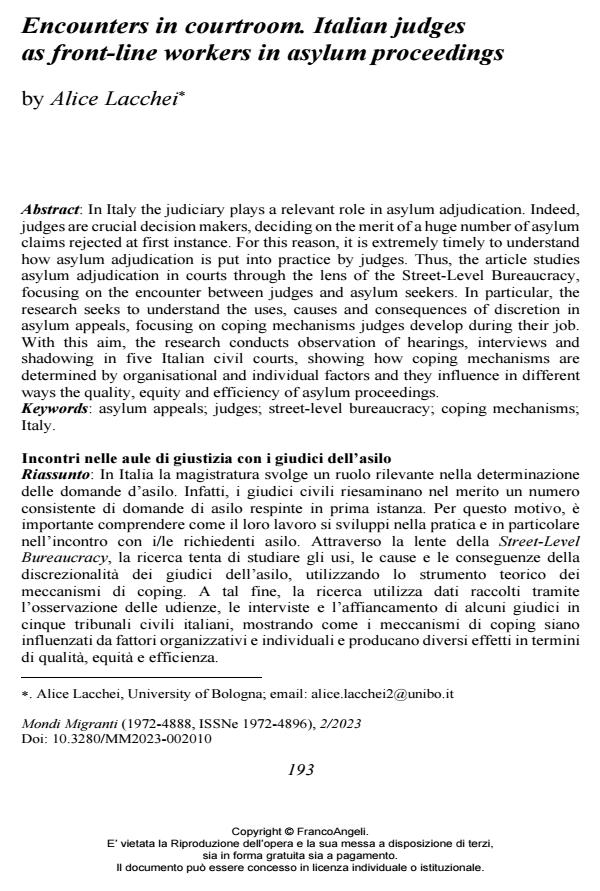Encounters in courtroom. Italian judges as front-line workers in asylum proceedings
Titolo Rivista MONDI MIGRANTI
Autori/Curatori Alice Lacchei
Anno di pubblicazione 2023 Fascicolo 2023/2
Lingua Inglese Numero pagine 22 P. 193-214 Dimensione file 209 KB
DOI 10.3280/MM2023-002010
Il DOI è il codice a barre della proprietà intellettuale: per saperne di più
clicca qui
Qui sotto puoi vedere in anteprima la prima pagina di questo articolo.
Se questo articolo ti interessa, lo puoi acquistare (e scaricare in formato pdf) seguendo le facili indicazioni per acquistare il download credit. Acquista Download Credits per scaricare questo Articolo in formato PDF

FrancoAngeli è membro della Publishers International Linking Association, Inc (PILA)associazione indipendente e non profit per facilitare (attraverso i servizi tecnologici implementati da CrossRef.org) l’accesso degli studiosi ai contenuti digitali nelle pubblicazioni professionali e scientifiche
In Italy the judiciary plays a relevant role in asylum adjudication. Indeed, judges are crucial decision makers, deciding on the merit of a huge number of asylum claims rejected at first instance. For this reason, it is extremely timely to understand how asylum adjudication is put into practice by judges. Thus, the article studies asylum adjudication in courts through the lens of the Street-Level Bureaucracy, focusing on the encounter between judges and asylum seekers. In particular, the research seeks to understand the uses, causes and consequences of discretion in asylum appeals, focusing on coping mechanisms judges develop during their job. With this aim, the research conducts observation of hearings, interviews and shadowing in five Italian civil courts, showing how coping mechanisms are determined by organisational and individual factors and they influence in different ways the quality, equity and efficiency of asylum proceedings.
In Italia la magistratura svolge un ruolo rilevante nella determinazione delle domande d’asilo. Infatti, i giudici civili riesaminano nel merito un numero consistente di domande di asilo respinte in prima istanza. Per questo motivo, è importante comprendere come il loro lavoro si sviluppi nella pratica e in particolare nell’incontro con i/le richiedenti asilo. Attraverso la lente della Street-Level Bureaucracy, la ricerca tenta di studiare gli usi, le cause e le conseguenze della discrezionalità dei giudici dell’asilo, utilizzando lo strumento teorico dei meccanismi di coping. A tal fine, la ricerca utilizza dati raccolti tramite l’osservazione delle udienze, le interviste e l’affiancamento di alcuni giudici in cinque tribunali civili italiani, mostrando come i meccanismi di coping siano influenzati da fattori organizzativi e individuali e producano diversi effetti in termini di qualità, equità e efficienza.
Parole chiave:ricorsi sull’asilo; giudici; street-level bureaucracy; meccanismi di coping; Italia.
- “Countries you go, asylum adjudication you find.” Asylum appeals implementation arrangements, actors' discretion, and organizational practices Cristina Dallara, Alice Lacchei, in Review of Policy Research /2025 pp.164
DOI: 10.1111/ropr.12605 - Civil Society Actors and the 2020 Italian Amnesty: Bordering to Deborder? Paola Bonizzoni, Minke Hajer, in Journal of Intercultural Studies /2023 pp.44
DOI: 10.1080/07256868.2022.2134317
Alice Lacchei, Encounters in courtroom. Italian judges as front-line workers in asylum proceedings in "MONDI MIGRANTI" 2/2023, pp 193-214, DOI: 10.3280/MM2023-002010